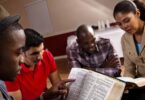 If you want to learn architecture, you must first learn how buildings are put together. If you want to learn sailing, you must first learn how ships are put together. And if you want to learn to understand the Bible, you must first learn how the Bible is put together.
If you want to learn architecture, you must first learn how buildings are put together. If you want to learn sailing, you must first learn how ships are put together. And if you want to learn to understand the Bible, you must first learn how the Bible is put together.
THE OLD AND NEW TESTAMENTS
The Bible has two major divisions: the Old Testament and the New Testament. The Old Testament begins with creation and tells the story of the Jewish people up to the time of Christ. It is made up of thirty-nine (39) individual “books” (the Book of Genesis, the Book of Exodus, etc.) written by twenty-eight different authors and spans a period of over two thousand years.
The New Testament is the record of the birth of Jesus, His life and ministry, and the ministry of His disciples, which was carried on after Jesus was crucified. The New Testament is composed of twenty-seven (27) books written by nine different authors and covers a time period of less than one hundred years. The total number of books in the entire Bible is sixty-six (66).
| Genesis | 2 Chronicles | Daniel |
| Exodus | Ezra | Hosea |
| Leviticus | Nehemiah | Joel |
| Numbers | Esther | Amos |
| Deuteronomy | Job | Obadiah |
| Joshua | Psalms | Jonah |
| Judges | Proverbs | Micah |
| Ruth | Ecclesiastes | Nahum |
| 1 Samuel | Song Of Solomon | Habakkuk |
| 2 Samuel | Isaiah | Zephaniah |
| 1 Kings | Jeremiah | Haggia |
| 2 Kings | Lamentations | Zechariah |
| 1 Chronicles | Ezekiel | Malachi |
| Matthew | Ephesians | Hebrews |
| Mark | Philippians | James |
| Luke | Colossians | 1 Peter |
| John | 1 Thessalonians | 2 Peter |
| Acts | 2 Thessalonians | 1 John |
| Romans | 1 Timothy | 2 John |
| 1 Corinthians | 2 Timothy | 3 John |
| 2 Corinthians | Titus | Jude |
| Galatians | Philemon | Revelation |
THE OLD TESTAMENT
Here is the key to understanding the Old Testament. Of the thirty-nine books in the Old Testament, there are three different kinds of books: Historical Books, Poetical Books and Prophetical Books.
If you know what kind of book you are reading, then you will know what kind of information to expect, and you can easily follow the logical flow of the Old Testament!
In the Old Testament:
… first seventeen books are historical,
… next five books are poetical, and
… the next seventeen books are prophetical!
| Historical | Poetical | Prophetical |
| Genesis | Job | Isaiah |
| Exodus | Pslams | Jeremiah |
| Leviticus | Proverbs | Lamentations |
| Numbers | Ecclesiastes | Ezekiel |
| Deuteronomy | Song of Solomon | Daniel |
| Joshua | Hosea | |
| Judges | Joel | |
| Ruth | Amos | |
| 1 Samuel | Obadiah | |
| 2 Samuel | Jonah | |
| 1 Kings | Micah | |
| 2 Kings | Nahum | |
| 1 Chronicles | Habakkuk | |
| 2 Chronicles | Zephaniah | |
| Ezra | Haggai | |
| Nehemiah | Zechariah | |
| Esther | Malachi |
If you want to read the story of the Hebrew nation in the Old Testament, you must read the first seventeen books. These books compose a historical time line for the nation of Israel.
If you want to read the poetry of Israel, you must read the next five books of the Old Testament.
If you want to read about the prophecy of Israel, you must read the final seventeen books.
This is somewhat oversimplified, because there is some poetry in the Historical Books, and some history in the Prophetical Books, etc. The point is, however, that each of the books fits into a primary category. If you keep this structure in mind, the Old Testament will begin to take shape for you.
Of the seventeen Historical Books, eleven are primary Historical Books and six are secondary Historical Books. The history of Israel is advanced in the eleven primary books and repeated or amplified in the six secondary books. The Poetical and Prophetical Books were written during the time period that is constructed in the first seventeen books.
THE NEW TESTAMENT
Of the twenty-seven books of the New Testament , there are also three different kinds of books: Historical Books,Pauline Epistles, and General Epistles.
The Historical Books are the four Gospels and the Acts of the Apostles.
The Epistles were letters written to various individuals and church congregations. The Pauline Epistles were letters written by the apostle Paul. The General Epistles were letters written to individuals and congregations by a number of different people, hence the rather generic name General Epistles. The primary content in all the Epistles is instruction on Christian doctrine and lifestyle.
| Historical | Pauline | General |
| Mathew | TO CHURCHES: | Hebrews |
| Mark | Romans | James |
| Luke | 1 Corinthians | 1 Peter |
| John | 2 Corinthians | 2 Peter |
| Acts | Galatians | 1 John |
| Ephesians | 2 John | |
| Philipians | 3 John | |
| Colossians | Jude | |
| 1 Thessalonians | Revelation | |
| 2 Thessalonians | ||
| TO INVIDUALS: | ||
| 1 Timothy | ||
| 2 Timothy | ||
| Titus | ||
| Philemon |
If you want to read the story of Jesus and the Church He established, you must read the first five books of the New Testament. These five books form the historical framework for understanding the entire New Testament!
If you want to read the apostle Paul’s instruction to churches and individuals, you must read the next thirteen books.
If you want to read the instruction to churches and individuals by men like the apostles Peter and John, you must read the final nine books of the New Testament.
REFERENCES
To find something in the Bible, you use a standard reference system. This consists of the name of the book of the Bible, the chapter number followed by a colon, and the verse number (each chapter is divided into numbered verses).
For example, Genesis 1:1 would be:
| Genesis | 1: | 1 |
| (Book) | (Chapter) | (Verse) |
When you see a reference such as Joshua 1:21, you will either have to memorize the books of the Bible to know where Joshua is, or you can look it up in the table of contents. It is well worth the time to memorize the books, and it is easiest to memorize them according to their categories.
For example, you now know that there are three types of books in the Old Testament (Historical, Poetical, and Prophetical) and the New Testament (Historical, Pauline Epistles, and General Epistles), and how many books are in each section. Memorize the first seventeen Historical Books. Then, when you have these memorized, learn the five Poetical Books, and so on. This system is much easier than attempting to memorize an unbroken list of sixty-six books.
Source: 30 Days To Understanding The Bible by Max Anders







